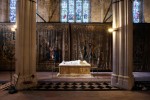 The Life of Christ tapestries have made their triumphant return to public view for the first time since a 2001 fire almost reduced these precious 17th century masterpieces to cinders. As of March 21st, they are hanging in the Cathedral Church of St. John the Divine in Manhattan. It has taken a decade and a half of painstaking labor from conservators for this day to arrive.
The Life of Christ tapestries have made their triumphant return to public view for the first time since a 2001 fire almost reduced these precious 17th century masterpieces to cinders. As of March 21st, they are hanging in the Cathedral Church of St. John the Divine in Manhattan. It has taken a decade and a half of painstaking labor from conservators for this day to arrive.
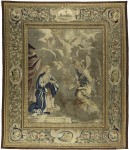 The story begins with a pope who had a great love of luxury textiles and an even greater love of nepotism. Maffeo Barberini was elected to the Throne of St. Peter as Pope Urban VIII in 1623 and wasted no time in spreading the ecclesiastical wealth around to his family members. He made his brother Antonio a cardinal. He made his brother Carlo’s sons Francesco and Antonio cardinals too. Other family members got grand titles (Duke, Prince), extensive properties in the Papal States, cushy sinecures and military commands requiring little in the way of actual soldiering.
The story begins with a pope who had a great love of luxury textiles and an even greater love of nepotism. Maffeo Barberini was elected to the Throne of St. Peter as Pope Urban VIII in 1623 and wasted no time in spreading the ecclesiastical wealth around to his family members. He made his brother Antonio a cardinal. He made his brother Carlo’s sons Francesco and Antonio cardinals too. Other family members got grand titles (Duke, Prince), extensive properties in the Papal States, cushy sinecures and military commands requiring little in the way of actual soldiering.
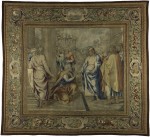 Rome was not known for its tapestry industry — France and Flanders dominated tapestry production in Europe — but for a brief window in the 17th century, it came to prominence thanks entirely to Cardinal Francesco Barberini, Urban’s nephew. He founded a private tapestry workshop in 1627, hand-picked its staff and oversaw the production of six multi-tapestry series depicting the early history of Christianity and the Church.
Rome was not known for its tapestry industry — France and Flanders dominated tapestry production in Europe — but for a brief window in the 17th century, it came to prominence thanks entirely to Cardinal Francesco Barberini, Urban’s nephew. He founded a private tapestry workshop in 1627, hand-picked its staff and oversaw the production of six multi-tapestry series depicting the early history of Christianity and the Church.
His papal uncle shared Francesco’s love for tapestries, the more silk, gold and silver thread the better. He already had a large collection before he was elected pope. After the dramatic improvement in family status, Francesco’s workshop gave the Barberini the opportunity to create personalized tapestries by the greatest artists in the richest materials, the kind of access only royalty (and in Italy, the Medici family of Florence) had.
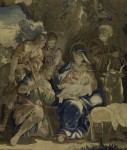 The Life of Christ cycle, designed by Giovanni Francesco Romanelli and woven by Gaspare Rocci, Caterina della Riviera and Maria Maddalena della Riviera, monopolized the workshop from 1643 to 1656. There were some gaps in there due to unforseen obstacles. Urban VIII died in 1644, severely hampering the production schedule. The new pope was no Barberini fan, and Francesco was soon tied up with investigations of his alleged misappropriation of funds. Production cranked back into gear in 1647, but it still took another nine years to complete the series.
The Life of Christ cycle, designed by Giovanni Francesco Romanelli and woven by Gaspare Rocci, Caterina della Riviera and Maria Maddalena della Riviera, monopolized the workshop from 1643 to 1656. There were some gaps in there due to unforseen obstacles. Urban VIII died in 1644, severely hampering the production schedule. The new pope was no Barberini fan, and Francesco was soon tied up with investigations of his alleged misappropriation of funds. Production cranked back into gear in 1647, but it still took another nine years to complete the series.
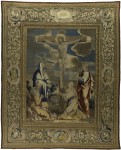 The workshop died with Francesco, its driving impetus, in 1679, and that was the end of Rome’s brief moment of relevance in the history of Baroque tapestry. The Life of Christ cycle hung on the walls of the Barberini family palaces until it was purchased along with the rest of the Barberini tapestry collection (135 in total) by wool manufacturer and tapestry expert Charles Mather Ffoulke in 1889. He moved them to the States where he resold the Life of Christ tapestries to Mrs. Elizabeth U. Coles. A devout congregant, Coles donated the complete series to the Cathedral of Saint John the Divine in 1891, before the church was built.
The workshop died with Francesco, its driving impetus, in 1679, and that was the end of Rome’s brief moment of relevance in the history of Baroque tapestry. The Life of Christ cycle hung on the walls of the Barberini family palaces until it was purchased along with the rest of the Barberini tapestry collection (135 in total) by wool manufacturer and tapestry expert Charles Mather Ffoulke in 1889. He moved them to the States where he resold the Life of Christ tapestries to Mrs. Elizabeth U. Coles. A devout congregant, Coles donated the complete series to the Cathedral of Saint John the Divine in 1891, before the church was built.
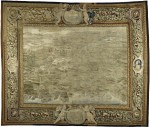 The Barberini tapestries were added to by other donors, until by the mid-20th century, Saint John the Divine found itself the proud owner of Flemish tapestries depicting the Acts of the Apostles made from Raphael cartoons and nine Mortlake tapestries. With such an important and unique collection, the Cathedral opened an in-house Textile Conservation Laboratory in 1981.
The Barberini tapestries were added to by other donors, until by the mid-20th century, Saint John the Divine found itself the proud owner of Flemish tapestries depicting the Acts of the Apostles made from Raphael cartoons and nine Mortlake tapestries. With such an important and unique collection, the Cathedral opened an in-house Textile Conservation Laboratory in 1981.
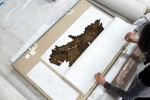 That expertise proved invaluable when tragedy struck in December 2001. A five-alarm fire broke out in the sanctuary, and the six Barberini tapestries hanging on the other side of the wall in the nave (the other six were already in the conservation lab when the fire started, thankfully) took heavy smoke and fire damage. Two of them, The Last Supper and The Resurrection, were so damaged that 30 to 40% of them were destroyed.
That expertise proved invaluable when tragedy struck in December 2001. A five-alarm fire broke out in the sanctuary, and the six Barberini tapestries hanging on the other side of the wall in the nave (the other six were already in the conservation lab when the fire started, thankfully) took heavy smoke and fire damage. Two of them, The Last Supper and The Resurrection, were so damaged that 30 to 40% of them were destroyed.
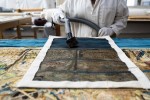 The conservation lab has been working on the delicate tapestries ever since. It’s a time-consuming, incredibly detailed job to clean and repair tapestries 16 feet tall and 12-19 feet wide one inch at a time. It has taken 16 years, but now 10 of the 12 tapestries of Life of the Christ have returned to the Cathedral of Saint John the Divine. The two heavily damaged ones have been stabilized, but are in no condition to be hung.
The conservation lab has been working on the delicate tapestries ever since. It’s a time-consuming, incredibly detailed job to clean and repair tapestries 16 feet tall and 12-19 feet wide one inch at a time. It has taken 16 years, but now 10 of the 12 tapestries of Life of the Christ have returned to the Cathedral of Saint John the Divine. The two heavily damaged ones have been stabilized, but are in no condition to be hung.
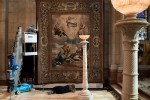 Instead of being installed way up high above the transepts as they were before the fire, they are now hanging in three chapels at eye level.
Instead of being installed way up high above the transepts as they were before the fire, they are now hanging in three chapels at eye level.
The Rev. Canon Patrick Malloy, the priest who oversees arts-related projects at the cathedral, in the Morningside Heights neighborhood of Manhattan, said the idea was to recreate a Baroque chapel and show the tapestries differently from when they hung over the transepts. But he said the exhibition was more than just that.
“They’re hanging in a liturgical space,” Dr. Malloy said, “so they’re not just works of art but devotional objects. It wouldn’t be the same if they were in the Met. I go to the Cloisters from time to time. It’s wonderful, but it’s not the same as if it were a monastery.”
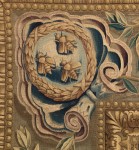 The new installation will give visitors the chance to examine the tapestries in much more detail. Tangential to the religious theme of the tapestries but very much central to the monarchical power they were meant to telegraph, the three bees on the Barberini family coat of arms are plastered in the four corners of each tapestry.
The new installation will give visitors the chance to examine the tapestries in much more detail. Tangential to the religious theme of the tapestries but very much central to the monarchical power they were meant to telegraph, the three bees on the Barberini family coat of arms are plastered in the four corners of each tapestry.
The Barberini bees are a common sight in Rome. After the elevation of Urban VIII to the papacy, he slapped those bees on everything from Barberini properties, to the bronze baldachin in St. Peter’s made of ancient Roman beams stolen from the Pantheon and melted down, to frescoes in the Vatican made a dozen years before Maffeo was even ordained a priest.
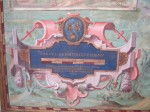 Of course they were woven into the tapestries, just as the kings of France wove their fleurs-de-lis on the tapestries they commissioned. The ones in the corners are the traditional three bees, two on top, one on the bottom, encircled by a laurel wreath in place of the shield, but the bees also appear on the tapestries in a rather bizarre tableau that I’ve never seen before, notwithstanding the Barberini penchant for scattering their pollinators far and wide in the city of Rome. There are three bees, yes, but two of them are pulling a plough while one rides above them holding a whip. This curious arrangement is apparently a very, very arcane reference to Virgil’s Georgics, and symbolizes the powerful combination of “highest rule, sown fields of cultivated land, production of honey.” It may be a nod to Urban’s three nephews — Francesco, Antonio and Taddeo — who held the three highest offices (not counting the pope, of course) of the Roman Church and whose combined labors were meant to ensure the continued wealth and victory of the Church.
Of course they were woven into the tapestries, just as the kings of France wove their fleurs-de-lis on the tapestries they commissioned. The ones in the corners are the traditional three bees, two on top, one on the bottom, encircled by a laurel wreath in place of the shield, but the bees also appear on the tapestries in a rather bizarre tableau that I’ve never seen before, notwithstanding the Barberini penchant for scattering their pollinators far and wide in the city of Rome. There are three bees, yes, but two of them are pulling a plough while one rides above them holding a whip. This curious arrangement is apparently a very, very arcane reference to Virgil’s Georgics, and symbolizes the powerful combination of “highest rule, sown fields of cultivated land, production of honey.” It may be a nod to Urban’s three nephews — Francesco, Antonio and Taddeo — who held the three highest offices (not counting the pope, of course) of the Roman Church and whose combined labors were meant to ensure the continued wealth and victory of the Church.
I don’t know if any of that makes much sense, but I’m kind of crazy about the image of the Barberini bees pushing that plough with their tiny bee hands while their brother/overseer cracks the whip.
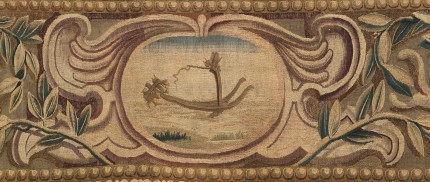
Maybe some sort of joke: “Quod non fecerunt barbari, fecerunt Barberini” – Instead of bees, it had originally been the dark giant biting horsefly (tabanus sudeticus), i.e. the heaviest fly in Europe, on the Barberini coat of arms.
In 1653, notably after Maffeo’s death in 1644, the tomb of the Merovingian king Childeric I was discovered in what is now Belgium. Among other objects it contained about 300 small bees of gold and garnet cloisonné, also antecedents of the Napoleonic ⚜⚜⚜.
Of course, the Fleur-de-Lis and Childeric himself were known long before Maffeo was even born. However, politics, the ‘Italian Wars’ of the 16th century and -last but not least- tapestry experts from abroad might have played a role here.
“St. John the Divine”: it’s no wonder that non-Christians often view Christians as polytheists.
The Cathedral of St. John the Divine is Episcopalian, not Catholic, and Mrs. Cole was one of its communicants.
Reminding us once again why we had a Reformation and that the Bourbons were not the only ones who forgot nothing and learned nothing! In the spiritual and political crises of those centuries the Cardinals amused themselves thus. One can see why they cling like limpets to the idea of the Petrine Mandate: “I’m the pope so if I say it’s OK, God says it’s OK!”. Or in other words, I can do whatever I want and then absolve myself. I wonder what Christ would say to that?
It would be very interesting to see photos of the tapestries with their original color restored. I’m sure that they would be close to gaudy to modern eyes, something akin to the Sistine Chapel before an after restoration.
The photos of them hanging are the restored tapestries, but alas, there are no high resolution photos of the restored tapestries alone that I could find. Judging from the two photos of the restored works in the post, the colors are more saturated, but not at garish. It’s a very different medium from fresco. I’m not sure it would be possible to bring the full intensity of the original colors and metallics without major reweaving.
Excellent article. As an expert in Barberini history (and as curator of this exhibition, to boot) I can say that you’ve done your homework more than any of the other journalists who’ve covered the exhibition (and some of them have been quite good). Thanks for your insightful summary–the best on the web!
That is the highest compliment you could have paid me. I suspect even the best reporters don’t have the time or column inches to delve as deeply into the context as I would wish to. I am bound by no such strictures so I can let my passion for the subject take me wherever it leads. Thank you for your kind words. I called my mother to have her read it and you made her blissfully happy too. 🙂
As to the objections to the frivolity of the churchmen (Rob–I love your comment about the Bourbons), I think it’s worth remembering that in the period of the counterreformation stirring the faith of the people through splendid artworks was considered a valid and purposeful strategy. Hindsight is always 20/20…
Tafani was the original Barberini family name. It means “Horsefly”. Urban VIII changes the the coat of arms from three horseflies to three bees. Bees have two pairs of wings and flies have one pair. Representations seem to vary or are unclear.
Devine in this case refers to a seer or prophet. He is also referred to as John of Patmos and credited with writing the book of Revelations.
¡Ojo! – Not even Roberto expects the Spanish Inquisition! :facepalm:
Why I love this blog: Not only are the topics themselves well-researched and insightfully written, I learn about things I didn’t even know enough about to ask. Origins and evolution of heraldic symbols. Some of the factors inducing those changes. The background of honorifics attached to religious figures (and how we often mangle things by interpreting them by assuming modern equivalency). This post and its comments, taken together, create a timeline linking the tapestries to cultures and individuals, through not only centuries, but possibly millenia. I can see a fascinating and complex documentary there. (Though right now I admit to a fascination with the little gold and garnet cloisonné bees mentioned in passing…)
Thank you, Annie. I agree, this is a great comment thread. There’s more about Childeric’s wonderful bees in this post.
Oh, good, another thing to do when I’m in NYC in June.
By a odd coincidence, I’m reading a book in which various Barberinis figure, although only peripherally. (Craig A. Monson’s Habitual Offenders: A True Tale of Nuns, Prostitutes, and Murderers in Seventeenth-Century Italy.)
That may be the greatest title for a history book ever. One of my favorite classes in college was a French literature course called “The Female Prison: Convents and Brothels.” Truly fascinating reading, from Diderot to Les Liasons Dangereuses. And the professor always brought us hot chocolate and peanut butter cookies. If I could take that class all over again, I would without hesitation.
I’m sure I don’t even have to tell I’ve added that book to my wishlist. :hattip:
Monson has written a couple of other books along similar lines, Nuns Behaving Badly, and Divas in the Convent. He’s a musicologist, but his researches into monastic music of the Italian Renaissance has led him into some very intriguing byways!